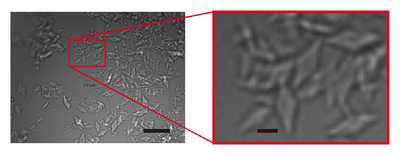Journal:Acta Cryst F:S2053230X21008967
From Proteopedia
(Difference between revisions)

| Line 12: | Line 12: | ||
<scene name='89/891404/Cv/3'>The overall structure of AGAO determined by SFX</scene> had almost the same conformation as those determined previously by synchrotron X-ray and neutron crystallography performed at cryogenic temperature. AGAO functions as a dimer, but in the crystals obtained in this study, the unit cell contained the monomer of AGAO (shown in a green ribbon model) in the asymmetric unit. The counter subunit forming the dimer is also shown as a royal blue trace model. The electron-density map in the active site clearly showed the resting form of <scene name='89/891404/Cv/6'>the protein-derived cofactor, 2,4,5-trihydroxyphenylalanine quinone (TPQ)</scene>. In addition, the <scene name='89/891404/Cv/7'>active-site Cu2+ was ligated with three histidine residues and two water molecules</scene> that are located at positions identical to those determined by the previous studies. The assigned stick models are shown for residue 382 (TPQ) and the Cu2+ and Cu2+-ligands (His431, His433, His592, Wax, and Weq), in which Wax and Weq are the axially and equatorially Cu2+-coordinating water molecules, respectively. These results show that the bound Cu2+ in AGAO is resistant to X-ray photoreduction, which is accompanied by conformational changes of the metal coordination structure. The availability of high-quality microcrystals in large quantities is promising for studying the structural changes of AGAO during the catalytic reaction by the ‘mix-and-inject’ time-resolved SFX. | <scene name='89/891404/Cv/3'>The overall structure of AGAO determined by SFX</scene> had almost the same conformation as those determined previously by synchrotron X-ray and neutron crystallography performed at cryogenic temperature. AGAO functions as a dimer, but in the crystals obtained in this study, the unit cell contained the monomer of AGAO (shown in a green ribbon model) in the asymmetric unit. The counter subunit forming the dimer is also shown as a royal blue trace model. The electron-density map in the active site clearly showed the resting form of <scene name='89/891404/Cv/6'>the protein-derived cofactor, 2,4,5-trihydroxyphenylalanine quinone (TPQ)</scene>. In addition, the <scene name='89/891404/Cv/7'>active-site Cu2+ was ligated with three histidine residues and two water molecules</scene> that are located at positions identical to those determined by the previous studies. The assigned stick models are shown for residue 382 (TPQ) and the Cu2+ and Cu2+-ligands (His431, His433, His592, Wax, and Weq), in which Wax and Weq are the axially and equatorially Cu2+-coordinating water molecules, respectively. These results show that the bound Cu2+ in AGAO is resistant to X-ray photoreduction, which is accompanied by conformational changes of the metal coordination structure. The availability of high-quality microcrystals in large quantities is promising for studying the structural changes of AGAO during the catalytic reaction by the ‘mix-and-inject’ time-resolved SFX. | ||
| - | PDB reference: room-temperature structure of bacterial copper amine oxidase determined by serial femtosecond crystallography, [[7f8k]]. | + | '''PDB reference:''' room-temperature structure of bacterial copper amine oxidase determined by serial femtosecond crystallography, [[7f8k]]. |
<b>References</b><br> | <b>References</b><br> | ||
Current revision
| |||||||||||
This page complements a publication in scientific journals and is one of the Proteopedia's Interactive 3D Complement pages. For aditional details please see I3DC.

